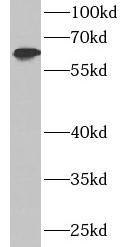Products
IFIT3 antibody
| Synonyms: | Interferon-induced protein with tetratricopeptide repeats 3 (IFIT-3)|CIG49|ISG-60|Interferon-induced 60 kDa protein (IFI-60K)|Interferon-induced protein with tetratricopeptide repeats 4 (IFIT-4)|Retinoic acid-induced gene G protein (P60 antibody, RIG-G)|IFIT3|CIG-49|IFI60|IFIT4|ISG60 antibody | ||
| Catalogue No.: | FNab04138 | Reactivity: | Human, Mouse |
| Host: | Rabbit | Tested Application: | ELISA, WB, IHC, IP |
| Clonality: | polyclonal | Isotype: | IgG |
| Size | Price |
|---|---|
| 100µg | Inquiry |
- SPECIFICATIONS
- FIGURES
- CONDITIONS
- FAQS
- Product Name
- IFIT3 antibody
- Catalogue No.
- FNab04138
- Size
- 100μg
- Form
- liquid
- Purification
- Immunogen affinity purified
- Purity
- ≥95% as determined by SDS-PAGE
- Clonality
- polyclonal
- Isotype
- IgG
- Storage
- PBS with 0.02% sodium azide and 50% glycerol pH 7.3, -20℃ for 12 months(Avoid repeated freeze / thaw cycles.)
- Immunogen
- interferon-induced protein with tetratricopeptide repeats 3
- Alternative Names
- Interferon-induced protein with tetratricopeptide repeats 3 (IFIT-3)|CIG49|ISG-60|Interferon-induced 60 kDa protein (IFI-60K)|Interferon-induced protein with tetratricopeptide repeats 4 (IFIT-4)|Retinoic acid-induced gene G protein (P60 antibody, RIG-G)|IFIT3|CIG-49|IFI60|IFIT4|ISG60 antibody
- UniProt ID
- O14879
- Observed MW
- 60 kDa
- Tested Applications
- ELISA, WB, IHC, IP
- Recommended dilution
- WB: 1:500-1:1000; IP: 1:500-1:1000; IHC: 1:50-1:200
 HepG2 cells were subjected to SDS PAGE followed by western blot with FNab04138(IFIT3 antibody) at dilution of 1:600
HepG2 cells were subjected to SDS PAGE followed by western blot with FNab04138(IFIT3 antibody) at dilution of 1:600
 IP Result of anti-IFIT3 (IP: FNab04138, 3ug; Detection: FNab04138 1:500) with HepG2 cells lysate 1500ug.
IP Result of anti-IFIT3 (IP: FNab04138, 3ug; Detection: FNab04138 1:500) with HepG2 cells lysate 1500ug.
 Immunohistochemistry of paraffin-embedded human lung cancer tissue slide using FNab04138(IFIT3 Antibody) at dilution of 1:100
Immunohistochemistry of paraffin-embedded human lung cancer tissue slide using FNab04138(IFIT3 Antibody) at dilution of 1:100
- Background
- IFN-induced antiviral protein which acts as an inhibitor of cellular as well as viral processes, cell migration, proliferation, signaling, and viral replication. Enhances MAVS-mediated host antiviral responses by serving as an adapter bridging TBK1 to MAVS which leads to the activation of TBK1 and phosphorylation of IRF3 and phosphorylated IRF3 translocates into nucleus to promote antiviral gene transcription. Exihibits an antiproliferative activity via the up-regulation of cell cycle negative regulators CDKN1A/p21 and CDKN1B/p27. Normally, CDKN1B/p27 turnover is regulated by COPS5, which binds CDKN1B/p27 in the nucleus and exports it to the cytoplasm for ubiquitin-dependent degradation. IFIT3 sequesters COPS5 in the cytoplasm, thereby increasing nuclear CDKN1B/p27 protein levels. Upregulates CDKN1A/p21 by downregulating MYC, a repressor of CDKN1A/p21. Can negatively regulate the apoptotic effects of IFIT2.
How many times can antibodies be recycled?
First, usually it's not suggested to recycle antibodies. After use, buffer system of antibodies has changed. The storage condition of recycled antibodies for different customers also varies. Thus, the performance efficiency of recycled antibodies can’t be guaranteed. Besides, FineTest ever conducted the antibody recycling assay. Assay results show recycling times of different antibodies also varies. Usually, higher antibody titer allows more repeated use. Customers can determine based on experimental requirements.
Notes: After incubation, we recycle rest antibodies to centrifuge tube and store at 4℃. High titer antibodies can be stored for a minimum of one week. Reuse about three times.
What are components of FineTest antibody buffer?
Components of FineTest antibody buffer are usually PBS with proclin300 or sodium azide, BSA, 50% glycerol. Common preservative is proclin300 or sodium azide, which is widely applied in the lab and industry.
How about the storage temperature and duration of FineTest antibodies?
Most antibodies are stored at -20℃. Directly-labeled flow cytometry antibodies should be stored at 2 - 8℃. The shelf life is one year. If after sales issues for purchased antibodies appear, return or replacement is available. Usually, antibodies can be still used after the one-year warranty. We can offer technical support services.
Is dilution required for FineTest antibodies? What’s the dilute solution?
Directly-labeled flow cytometry antibodies are ready-to-use without dilution. Other antibodies are usually concentrated. Follow the dilution ratio suggested in the manual. Dilute solution for different experiments also varies. Common antibody dilution buffers are acceptable(e.g. PBST, TBST, antibody blocking buffer).
How to retrieve antibodies for immunohistochemistry?
Common retrieval buffers: Tris-EDTA Buffer(pH 9.0); Citrate Buffer(pH 6.0)
Heat induced antibody retrieval:
Method 1: Water-bath heating: Put the beaker with retrieval buffer and slide in the boiling water bath. Keep the boiling state for 15min. Naturally cool to room temperature;
Method 2: Microwave retrieval: Put the beaker with retrieval buffer and slide in the microwave oven. Heat at high power for 5min, Switch OFF for 3min, Heat at medium power for 5min. Naturally cool to room temperature.
How to choose secondary antibodies?
(1) Secondary antibodies react with primary antibodies. Thus, secondary antibodies should be against host species of primary antibodies. E.g. If the primary antibody is derived from rabbit, the relevant secondary antibody should be against rabbit. E.g. goat anti rabbit or donkey anti rabbit.
(2) Choose secondary antibody conjugates according to the experimental type, e.g. ELISA, WB, IHC etc. Common enzyme conjugated secondary antibodies are labelled by HRP, AP etc. Fluorescin or dye labelled secondary antibodies are applied in immunofluorescence and flow cytometry(e.g. FITC, Cy3).
